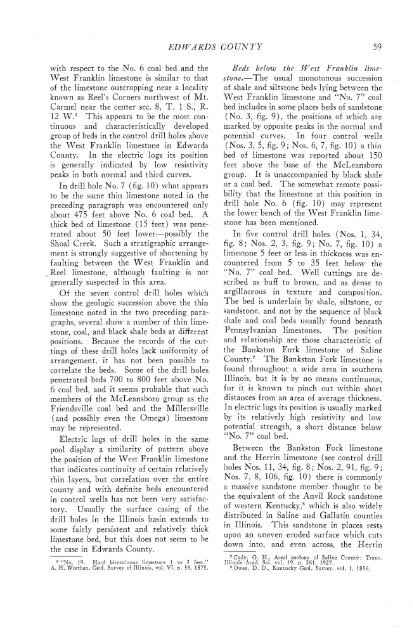subsurface geology and coal resources of the pennsylvanian system ...
subsurface geology and coal resources of the pennsylvanian system ...
subsurface geology and coal resources of the pennsylvanian system ...
You also want an ePaper? Increase the reach of your titles
YUMPU automatically turns print PDFs into web optimized ePapers that Google loves.
with respect to <strong>the</strong> No. 6 <strong>coal</strong> bed <strong>and</strong> <strong>the</strong><br />
West Franklin limestone is similar to that<br />
<strong>of</strong> <strong>the</strong> limestone outcropping near a locality<br />
known as Reel's Corners northwest <strong>of</strong> Mt.<br />
Carmel near <strong>the</strong> center sec. 8, T. 1 S., R.<br />
12 W.This appears to be <strong>the</strong> most continuous<br />
<strong>and</strong> characteristically developed<br />
group <strong>of</strong> beds in <strong>the</strong> control drill holes above<br />
<strong>the</strong> ?Vest Franklin limestone in Edwards<br />
County. In <strong>the</strong> electric logs its position<br />
is generally indicated by low resistivity<br />
peaks in both normal <strong>and</strong> third curves.<br />
In drill hole No. 7 (fig. 10) what appears<br />
to be <strong>the</strong> same thin limestone noted in <strong>the</strong><br />
preceding paragraph was encountered only<br />
about 475 feet above No. 6 <strong>coal</strong> bed. A<br />
thick bed <strong>of</strong> limestone (15 feet) was penetrated<br />
about 50 feet lower-possibly <strong>the</strong><br />
Shoal Creek. Such a stratigraphic arrangement<br />
is strongly suggestive <strong>of</strong> shortening by<br />
faulting between <strong>the</strong> West Franklin <strong>and</strong><br />
Reel limestone, although faulting is not<br />
generally suspected in this area.<br />
Of <strong>the</strong> seven control drill holes which<br />
show <strong>the</strong> geologic succession above <strong>the</strong> thin<br />
limestone noted in <strong>the</strong> two preceding paragraphs,<br />
several show a number <strong>of</strong> thin limestone,<br />
<strong>coal</strong>, <strong>and</strong> black shale beds at different<br />
positions. Because <strong>the</strong> records <strong>of</strong> <strong>the</strong> cuttings<br />
<strong>of</strong> <strong>the</strong>se drill holes lack uniformity <strong>of</strong><br />
arrangement, it has not been possible to<br />
correlate <strong>the</strong> beds. Some <strong>of</strong> <strong>the</strong> drill holes<br />
penetrated beds 700 to 800 feet above No.<br />
6 <strong>coal</strong> bed, <strong>and</strong> it seems probable that such<br />
members <strong>of</strong> <strong>the</strong> McLeansboro group as <strong>the</strong><br />
Friendsville <strong>coal</strong> bed <strong>and</strong> <strong>the</strong> Millersville<br />
(<strong>and</strong> possibly even <strong>the</strong> Omega) limestone<br />
may be represented.<br />
Electric logs <strong>of</strong> drill holes in <strong>the</strong> same<br />
pool display a similarity <strong>of</strong> pattern above<br />
<strong>the</strong> position <strong>of</strong> <strong>the</strong> West Franklin limestone<br />
that indicates continuity <strong>of</strong> certain relatively<br />
thin layers, but correlation over <strong>the</strong> entire<br />
county <strong>and</strong> with definite beds encountered<br />
in control wells has not been very satisfac-<br />
tory. Usually <strong>the</strong> surface casing <strong>of</strong> <strong>the</strong><br />
drill holes in <strong>the</strong> Illinois basin extends to<br />
some fairly persistent <strong>and</strong> relatively thick<br />
limestone bed, but this does not seem to be<br />
<strong>the</strong> case in Edwards County.<br />
EDWARDS COUNTY 59<br />
Beds below <strong>the</strong> West Franklin limestone.-The<br />
usual monotonous succession<br />
<strong>of</strong> shale <strong>and</strong> siltstone beds lying between <strong>the</strong><br />
West Franklin limestone <strong>and</strong> "No. 7" <strong>coal</strong><br />
bed includes in some places beds <strong>of</strong> s<strong>and</strong>stone<br />
(No. 3, fig. 9), <strong>the</strong> positions <strong>of</strong> which are<br />
marked by opposite peaks in <strong>the</strong> normal <strong>and</strong><br />
curves. In four control wells<br />
(Nos. 3, 5, fig. 9; Nos. 6, 7, fig. 10) a thin<br />
bed <strong>of</strong> limestone was reported about 150<br />
feet above <strong>the</strong> base <strong>of</strong> <strong>the</strong> McLeansboro<br />
group. It is unaccompanied by black shale<br />
or a <strong>coal</strong> bed. The somewhat remote possibility<br />
that <strong>the</strong> limestone at this position in<br />
drill hole No. 6 (fig. 10) may represent<br />
<strong>the</strong> lower bench <strong>of</strong> <strong>the</strong> West Franklin limestone<br />
has been mentioned.<br />
In five control drill holes (Nos. 1, 34,<br />
fig. 8; Nos. 2, 3, fig. 9; No. 7, fig. 10) a<br />
limestone 5 feet or less in thickness was encountered<br />
from 5 to 35 feet below <strong>the</strong><br />
"No. 7" <strong>coal</strong> bed. Well cuttings are described<br />
as buff to brown, <strong>and</strong> as dense to<br />
argillaceous in texture <strong>and</strong> composition.<br />
The bed is underlain by shale, siltstone, or<br />
s<strong>and</strong>stone, <strong>and</strong> not by <strong>the</strong> sequence <strong>of</strong> black<br />
shale <strong>and</strong> <strong>coal</strong> beds usually found beneath<br />
Pennsylvanian limestones. The position<br />
<strong>and</strong> relationship are those characteristic <strong>of</strong><br />
<strong>the</strong> Bankston Fork limestone <strong>of</strong> Saline<br />
C~unty.~ The Bankston Fork limestone is<br />
found throughout a wide area in sou<strong>the</strong>rn<br />
Illinois, but it is by no means continuous,<br />
for it is known to pinch out within short<br />
distances from an area <strong>of</strong> average thickness.<br />
In electric logs its position is usually marked<br />
by its relatively high resistivity <strong>and</strong> low<br />
potential strength, a short distance belo,w<br />
"No. 7" <strong>coal</strong> bed.<br />
Between <strong>the</strong> Bankston Fork limestone<br />
<strong>and</strong> <strong>the</strong> Herrin limestone (see control drill<br />
holes Nos. 11, 34, fig. 8 ; Nos. 2, 91, fig. 9;<br />
Nos. 7, 8, 106, fig. 10) <strong>the</strong>re is commonly<br />
a massive s<strong>and</strong>stone member thought to be<br />
<strong>the</strong> equivalent <strong>of</strong> <strong>the</strong> Anvil Rock s<strong>and</strong>stone<br />
<strong>of</strong> western Kent~cky,~ which is also widely<br />
distributed in Saline <strong>and</strong> Gallatin counties<br />
in Illinois. This s<strong>and</strong>stone in places rests<br />
upon an uneven eroded surface which cuts<br />
down into, <strong>and</strong> even across, <strong>the</strong> Herrin<br />
Cady. G. H., Areal <strong>geology</strong> <strong>of</strong> Saline County: Trans.<br />
O "No. 19. Hard bituminous limestone 1 to 3 feet." Illinois Arad. Sci. vol. 19. p. 261, 1927.<br />
A. If. Wor<strong>the</strong>n, Geol. Survey <strong>of</strong> Illinois, vol. VT, p. 56, 1875. Owcn, D. D., Kentucky Geol. Survey, vol. 1, 1856.
















